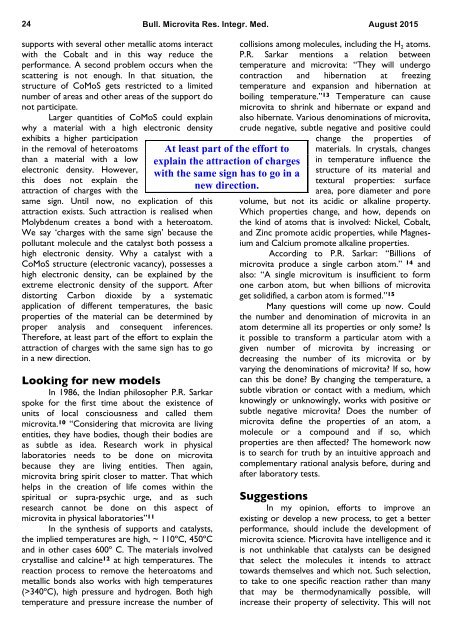B O M R I M
BOMRIM August 2015
BOMRIM August 2015
You also want an ePaper? Increase the reach of your titles
YUMPU automatically turns print PDFs into web optimized ePapers that Google loves.
24<br />
Bull. Microvita Res. Integr. Med. August 2015<br />
supports with several other metallic atoms interact<br />
with the Cobalt and in this way reduce the<br />
performance. A second problem occurs when the<br />
scattering is not enough. In that situation, the<br />
structure of CoMoS gets restricted to a limited<br />
number of areas and other areas of the support do<br />
not participate.<br />
Larger quantities of CoMoS could explain<br />
why a material with a high electronic density<br />
exhibits a higher participation<br />
in the removal of heteroatoms<br />
than a material with a low<br />
electronic density. However,<br />
this does not explain the<br />
attraction of charges with the<br />
same sign. Until now, no explication of this<br />
attraction exists. Such attraction is realised when<br />
Molybdenum creates a bond with a heteroatom.<br />
We say ‘charges with the same sign’ because the<br />
pollutant molecule and the catalyst both possess a<br />
high electronic density. Why a catalyst with a<br />
CoMoS structure (electronic vacancy), possesses a<br />
high electronic density, can be explained by the<br />
extreme electronic density of the support. After<br />
distorting Carbon dioxide by a systematic<br />
application of different temperatures, the basic<br />
properties of the material can be determined by<br />
proper analysis and consequent inferences.<br />
Therefore, at least part of the effort to explain the<br />
attraction of charges with the same sign has to go<br />
in a new direction.<br />
Looking for new models<br />
In 1986, the Indian philosopher P.R. Sarkar<br />
spoke for the first time about the existence of<br />
units of local consciousness and called them<br />
microvita. 10 “Considering that microvita are living<br />
entities, they have bodies, though their bodies are<br />
as subtle as idea. Research work in physical<br />
laboratories needs to be done on microvita<br />
because they are living entities. Then again,<br />
microvita bring spirit closer to matter. That which<br />
helps in the creation of life comes within the<br />
spiritual or supra-psychic urge, and as such<br />
research cannot be done on this aspect of<br />
microvita in physical laboratories” 11<br />
In the synthesis of supports and catalysts,<br />
the implied temperatures are high, ~ 110ºC, 450ºC<br />
and in other cases 600º C. The materials involved<br />
crystallise and calcine 12 at high temperatures. The<br />
reaction process to remove the heteroatoms and<br />
metallic bonds also works with high temperatures<br />
(>340ºC), high pressure and hydrogen. Both high<br />
temperature and pressure increase the number of<br />
At least part of the effort to<br />
explain the attraction of charges<br />
with the same sign has to go in a<br />
new direction.<br />
collisions among molecules, including the H 2 atoms.<br />
P.R. Sarkar mentions a relation between<br />
temperature and microvita: “They will undergo<br />
contraction and hibernation at freezing<br />
temperature and expansion and hibernation at<br />
boiling temperature.” 13 Temperature can cause<br />
microvita to shrink and hibernate or expand and<br />
also hibernate. Various denominations of microvita,<br />
crude negative, subtle negative and positive could<br />
change the properties of<br />
materials. In crystals, changes<br />
in temperature influence the<br />
structure of its material and<br />
textural properties: surface<br />
area, pore diameter and pore<br />
volume, but not its acidic or alkaline property.<br />
Which properties change, and how, depends on<br />
the kind of atoms that is involved: Nickel, Cobalt,<br />
and Zinc promote acidic properties, while Magnesium<br />
and Calcium promote alkaline properties.<br />
According to P.R. Sarkar: “Billions of<br />
microvita produce a single carbon atom.” 14 and<br />
also: “A single microvitum is insufficient to form<br />
one carbon atom, but when billions of microvita<br />
get solidified, a carbon atom is formed.” 15<br />
Many questions will come up now. Could<br />
the number and denomination of microvita in an<br />
atom determine all its properties or only some? Is<br />
it possible to transform a particular atom with a<br />
given number of microvita by increasing or<br />
decreasing the number of its microvita or by<br />
varying the denominations of microvita? If so, how<br />
can this be done? By changing the temperature, a<br />
subtle vibration or contact with a medium, which<br />
knowingly or unknowingly, works with positive or<br />
subtle negative microvita? Does the number of<br />
microvita define the properties of an atom, a<br />
molecule or a compound and if so, which<br />
properties are then affected? The homework now<br />
is to search for truth by an intuitive approach and<br />
complementary rational analysis before, during and<br />
after laboratory tests.<br />
Suggestions<br />
In my opinion, efforts to improve an<br />
existing or develop a new process, to get a better<br />
performance, should include the development of<br />
microvita science. Microvita have intelligence and it<br />
is not unthinkable that catalysts can be designed<br />
that select the molecules it intends to attract<br />
towards themselves and which not. Such selection,<br />
to take to one specific reaction rather than many<br />
that may be thermodynamically possible, will<br />
increase their property of selectivity. This will not


